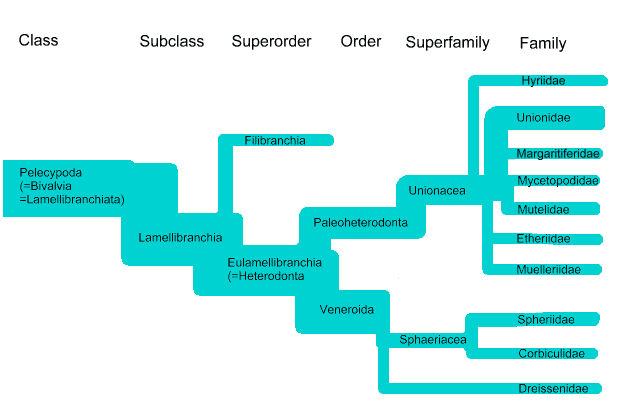Freshwater
Molluscan Shells
Bivalvia =
Pelecypoda
Order
Paleoheterodonta, Superfamily Unionoida or
Unionacea:
(pearly freshwater mussels, the following
seven families)
Margaritifera
Northern Hemisphere, discontinuous
Unionidae (North
American) (European) (Asian)
Hyriidae (Australian) (South
American)
Mycetopodidae (South
American)
Mutelidae (African)
Etheriidae
"river
oysters", Africa
Muelleridae
"river
oysters", South America, India
Order Veneroida
Sphaeriidae: pill clams
and fingernail clams. world wide.
Corbiculidae: basket
clams, mostly Asiatic, also South America.
Asiatic species are invasive in North America
South America, and Europe.
Dreissenidae: false
mussels and zebra mussels, invasive in North
America and Europe.
All bivalves are two-shelled
aquatic filter feeders that lack a head or
radula, and most live partly or completely buried
in sand or mud or attached to some firm surface.
There are on the order of 20,000 total species,
mostly marine, including the oysters, mussels,
and scallops, and a great variety of creatures
referred to as clams.
Bogan (2007) tabulates a total
of 1026 freshwater bivalve species in 206 genera
from 19 families in his treatment of worldwide
species diversity. Roughly 800 of those species
and 180 genera comprise the seven unionacean
families, making them by far the most successful
and diverse group of freshwater mollusks. All
unionaceans are commonly referred to as
"freshwater mussels" collectively, even
though "clam" would not be incorrect.
In addition to the unionaceans and the three
additional primarily freshwater families above, a
few species adapted to freshwater occur in the
generally marine families Arcidae, Mytilidae,
Cardiidae, Solenidae, Donacidae, Navaculidae,
Trapziidae, Corbulidae, Erodonidae, Teridinidae,
and Lyonsiidae. Some of these are included on the
page with the Dreissenidae
linked above.
 |
Family tree showing relationships between
major freshwater lineages of the Pelecypoda.
Arrangement is from Brusca and
Brusca, 1990. Filibranchia
includes the ark clams, marine mussels, scallops,
true oysters, pearl oysters, thorny oysters, etc,
mostly marine. Paleoheterodonta also includes the
nearly
extinct marine superfamily Trigoniacea (not
shown), while Veneroida includes most other
"clams". For another
perspective on Unionacean systematics, see the
dissertation by Graf, Chapter 7b
(pdf file). |
Stereo pair
of Fusconaia ebena, right valve
interior.
Picture arrangement is non-standard: sit well back from
screen and cross your eyes slightly.
[Home
Page] | [Site Map]
|